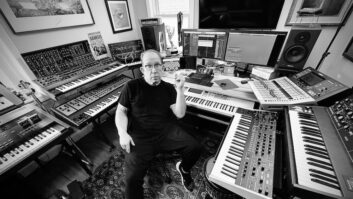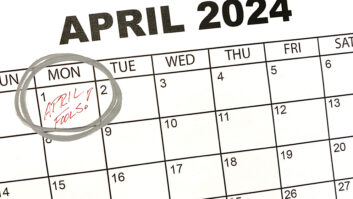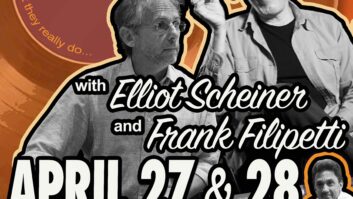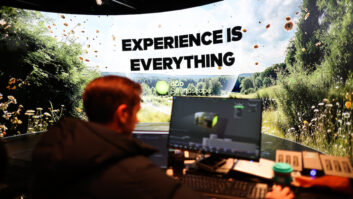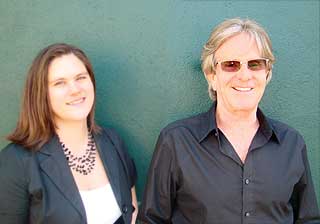
Owner Jeff Greenberg and studio manager Tina Morris. Greenberg says The Village is “doing more full albums than I would’ve expected.”
When it came to decide on the focus of my final column, I knew it could only be Jeff Greenberg, my friend of 35 years, and his baby, The Village Recorder. Not only was Greenberg the first person I interviewed for “Grapevine,” he had a lot to do with my getting this gig in the first place. During my subsequent travels, Greenberg’s name kept popping up, as studio owners, producers, engineers and artists alike expressed their respect and fondness for the guy and his big heart. A onetime manager, concert promoter and booking agent, Greenberg is one of the great characters of the L.A. music scene. He moves fast and talks faster—rattling out a torrent of info, free-association-style, sprinkled with hyperbole and punctuated by his trademark self-effacing asides. When I told him I wanted to do my final column on him, his first reaction was, “Just don’t make me look like a schmuck, okay?”
Taking over the floundering facility in 1995, Greenberg restored it to its former glory, and by the turn of the century, the Village had as much cache as any other high-end studio in L.A. Two years ago, he took the plunge, buying the 30,000-square-foot, three-story building, and he hasn’t looked back since. Why dive deeper into the studio business at a time like this, when major-label budgets are contracting?
“When I walk around the hallways, I’m constantly reminded of the legacy of this place, and I see the great artists who are working here every day,” Greenberg replies. “This is something I love, and I think the building is a great investment. When Geordie Hormel turned what had been a Masonic temple into a recording studio in 1968, he spared no expense, and when you look at the way these rooms are designed and constructed, the care and the materials used, it’s obvious you could never duplicate it today for any amount of money.”
When asked how things have changed during the four years I’ve been writing this column, studio manager (and new mom) Tina Morris points out, “The total-package project from tracking to mix is becoming less commonplace. Some of our clients track here on a large-format console and bring it home to mix in Pro Tools, and others track at home or in a smaller studio and then spend the money to mix it here.” But Greenberg is quick to note, “We’re still doing more full albums than I would’ve expected.”
T Bone Burnett has been spending a great deal of time at The Village on projects with Elton John and Leon Russell (the sessions documented by Cameron Crowe), Gregg Allman and Robert Randolph, as well as the soundtrack to Crazy Heart. Other current and recent clients in the main rooms have included Santana with Mike Plotnikoff, Seal and Andrea Bocelli with David Foster, and Lady Gaga with Nick Dresti (aka Space Cowboy), as well as Mary J. Blige, Weezer and Stevie Nicks. They’re all drawn to The Village’s can’t-miss combo of high-end Neve boards, top-notch gear, big tracking rooms, professional staff and good vibes.
The Village is the base of operations for several producers in residence: Robbie Robertson (the longtime occupant of C, where Sly and the Family Stone cut There’s a Riot Goin’ On), John Mayer, John Alagia, Ken Caillat (who fell in love with and married the studio’s receptionist during the recording of Fleetwood Mac’s Tusk; their daughter Colbie recorded her latest album here), Andrea Morricone (son of Ennio, the legendary Italian film composer) and Ed Cherney (Rose’s husband). The third floor houses the recording operations of Concord Records under chief engineer Seth Presant, who’s overseen sessions with George Benson, Lee Ritenour with Marcus Miller, Curtis Stigers, Robben Ford and Macy Gray. Presant and his staff work with a Digidesign ICON and a variety of outboard gear brought down from Fantasy Studios in Berkeley.
The facility also continues to host live sessions regularly put together by NPR Santa Monica tastemaker station KCRW (recently including Vampire Weekend, Spoon, Tom Jones and St. Vincent), while also doing sessions for MySpace Transmissions, Yahoo! Live and the BBC.
Apart from rock projects, The Village handles quite a bit of film music, including scores for The Hulk, Wall-E, Revolutionary Road and Public Enemies. The primary lure is the 84-channel Neve 88R console, outfitted with a film mix module and gold-plated contacts, in the completely renovated Studio B. “The 88R is now the console of choice,” Greenberg points out. “The scoring stages at Fox, Sony and Warner Bros. all have the same board, and because we have the film module, people find that it’s easy to transition to our studio. When it comes to audio, we’re doing the full spectrum.”
Greenberg has also been helping young bands get their start and mentoring them in the ways of the business. To that end, he’s in the process of launching his own indie label, The Village Records, in partnership with veteran promotion exec Bob Divney. Among their first signings is Russian rock ’n’ roll band Mumiy Troll, for whom Greenberg co-wrote and produced the track “Polar Bear.”
“There’s so much cool music going on now,” he says, still as exhilarated by the experience of watching artists and producers create as he was when I met him back in 1975. “I’ve never heard more exciting music in my life than I’m hearing right now. The floodgates are open.”
I can’t think of a better way to cap off this column than with that sentiment—one that I share with my old friend. Thanks for reading, keep on keepin’ on and I’ll see y’all down the line.
Bud Scoppa is a freelance writer based in the Los Angeles area. E-mail him at [email protected].

